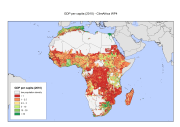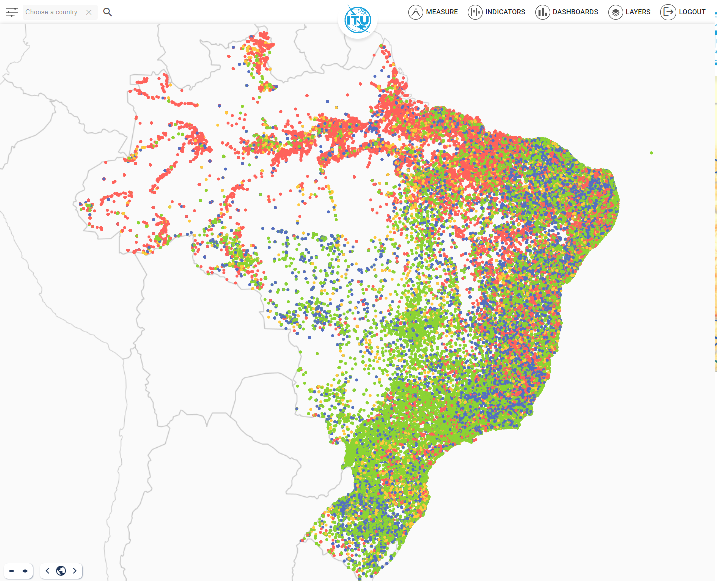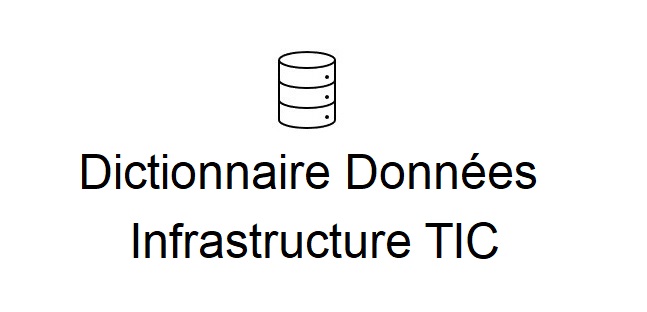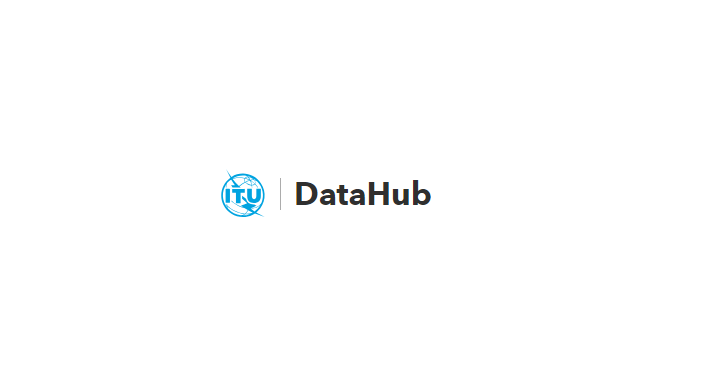Type of resources
Available actions
Topics
Keywords
Contact for the resource
Provided by
Years
Formats
Representation types
Update frequencies
status
Service types
Resolution
-

The G5 Accelerator brings together high-value tools and resources offering practical, step-by-step support for countries already embarked or planning to embark on their digital transformation journey. Discover the gold standard for collaborative digital policy and regulation.
-

Disaster Connectivity Map (DCM) Connectivity is a map layer of performance, that compiles quality of service (Qos) measurements received via third party providers from software probes installed on end-user devices. The measurements received from SpeedChecker are ping (Ms), download speed (Mbps) and upload speed (Mbps), which are processed into point grid cells of 100-km, 10-km, 1-km, and 100-m which are displayed at different zoom levels depending on scale that the map is zoomed to. The default style (‘point_download’) displays download speed from the ‘download’ attribute field, but changing the style to the ‘ping’ (‘point_ping’) or ‘upload’ (‘point_upload’) fields will display these indicators. DCM Connectivity is a rolling worldwide baseline map layer of measurement data, in which all data received is added cumulatively and the median average for each measurement is recalculated each time it is updated. When the DCM is in active mode, the DCM Connectivity map layer is updated hourly. This map layer does not have a time dimension or time field, so cannot be filtered by time.
-

The Gross Domestic Product per capita (gross domestic product divided by mid-year population converted to international dollars, using purchasing power parity rates) has been identified as an important determinant of susceptibility and vulnerability by different authors and used in the Disaster Risk Index 2004 (Peduzzi et al. 2009, Schneiderbauer 2007, UNDP 2004) and is commonly used as an indicator for a country’s economic development (e.g. Human Development Index). Despite some criticisms (Brooks et al. 2005) it is still considered useful to estimate a population’s susceptibility to harm, as limited monetary resources are seen as an important factor of vulnerability. However, collection of data on economic variables, especially sub-national income levels, is problematic, due to various shortcomings in the data collection process. Additionally, the informal economy is often excluded from official statistics. Night time lights satellite imagery of NOAA grid provides an alternative means for measuring economic activity. NOAA scientists developed a model for creating a world map of estimated total (formal plus informal) economic activity. Regression models were developed to calibrate the sum of lights to official measures of economic activity at the sub-national level for some target Country and at the national level for other countries of the world, and subsequently regression coefficients were derived. Multiplying the regression coefficients with the sum of lights provided estimates of total economic activity, which were spatially distributed to generate a 30 arc-second map of total economic activity (see Ghosh, T., Powell, R., Elvidge, C. D., Baugh, K. E., Sutton, P. C., & Anderson, S. (2010).Shedding light on the global distribution of economic activity. The Open Geography Journal (3), 148-161). We adjusted the GDP to the total national GDPppp amount as recorded by IMF (International Monetary Fund) for 2010 and we divided it by the population layer from Worldpop Project. Further, we ran a focal statistics analysis to determine mean values within 10 cell (5 arc-minute, about 10 Km) of each grid cell. This had a smoothing effect and represents some of the extended influence of intense economic activity for local people. Finally we apply a mask to remove the area with population below 1 people per square Km. This dataset has been produced in the framework of the "Climate change predictions in Sub-Saharan Africa: impacts and adaptations (ClimAfrica)" project, Work Package 4 (WP4). More information on ClimAfrica project is provided in the Supplemental Information section of this metadata.
-

-

-

Getting Started: The Data Catalog is designed to make World Bank's development data easy to find, download, use, and share. It includes data from the World Bank's microdata, finances and energy data platforms, as well as datasets from the open data catalog. There are different ways to access and download datasets. What is Data Catalog? The Data Catalog is a project to provide a more effective means for capture, acquisition, curation, access and use of development-Data Catalog data throughout the World Bank Group. The goal is to maximize the value and investment in data by increasing the potential for the data to be shared and reused, to minimize transaction costs in finding relevant data and data methodologies, and to prevent duplication. The project builds on existing expertise and resources such as the Microdata Library,Open Data Catalog and GFDRR. The Data Catalog provides a “One-Stop Shop” for development data produced, acquired or used by the World Bank in accordance with the Bank Procedure for Development Dataset Acquisition, Archiving and Dissemination, and the Guidance on Data Acquisition and Archiving. This includes metadata for datasets from other catalogs such as the Microdata Library, EnergyData.Info, Finances and World Bank Open Data API. Where needed, the Data Catalog also serves as a data storage repository, providing long-term storage for World Bank development data.
-

The world’s richest source of ICT statistics and regulatory information. Track the digital transformation with the ITU DataHub, featuring hundreds of ICT indicators on connectivity, markets, affordability, trust governance, and sustainability. Find, compare, and download data for nearly 200 economies.
-

Published by Collins Bartholomew in partnership with Global System for Mobile Communications (GSMA), the Mobile Coverage Explorer is a raster data representation of the area covered by mobile cellular networks around the world. Data_MCE global coverage has been sourced from the network operators and created from submissions made directly to Collins Bartholomew or to GSMA, from operators who provide roaming detail for inclusion in the GSMA’s Network Coverage Maps web application (https://www.gsma.com/coverage). The dataset is provided at Global and National level. Global datasets contain the merged global coverages with the following file naming convention. MCE_Global<Technology>_<DataRelease>, where technology is ‘4G’. At country level the rasters depict the network coverage in each country for each technology. Therefore a country is not defined by its border extent but rather by the coverage supplied by network operators with licences in that country. In the file naming convention, countries are identified using their ISO 3166-1 code as follows: MCE_<ISO2Code><Technology>_<DataRelease>. The cell value in the MCE rasters are as follows: 1 - strong signal 2 - variable signal strength This data is supplemented with coverage created from OpenCellID (please see link in the associated resources of this metadata).
-

Estimated density of people per grid-cell, approximately 1km (0.008333 degrees) resolution. The units are number of people per Km² per pixel, expressed as unit: "ppl/Km²". The mapping approach is Random Forest-based dasymetric redistribution. The WorldPop project was initiated in October 2013 to combine the AfriPop, AsiaPop and AmeriPop population mapping projects. It aims to provide an open access archive of spatial demographic datasets for Central and South America, Africa and Asia to support development, disaster response and health applications. The methods used are designed with full open access and operational application in mind, using transparent, fully documented and peer-reviewed methods to produce easily updatable maps with accompanying metadata and measures of uncertainty. Acknowledgements information at https://www.worldpop.org/acknowledgements
-

Range to a Fibre Notes (Access Points) layers from the ITU Broadband Mapping programme (BBmaps) and research The layer displays 10, 25 and 50 km of distance to a Fibre Node. This is used to calculate the Broadband Capacity Indicator 7 (Percentage of population within reach of transmission networks) The population living within reach of transmission networks is calculated from network nodes (points) rather than routes (lines), because nodes are access points to the network. This is the equivalent of a motorway: a motorway may pass through areas of high and low population density, but the only means of accessing the motorway are at junctions
 ITU GeoCatalogue
ITU GeoCatalogue